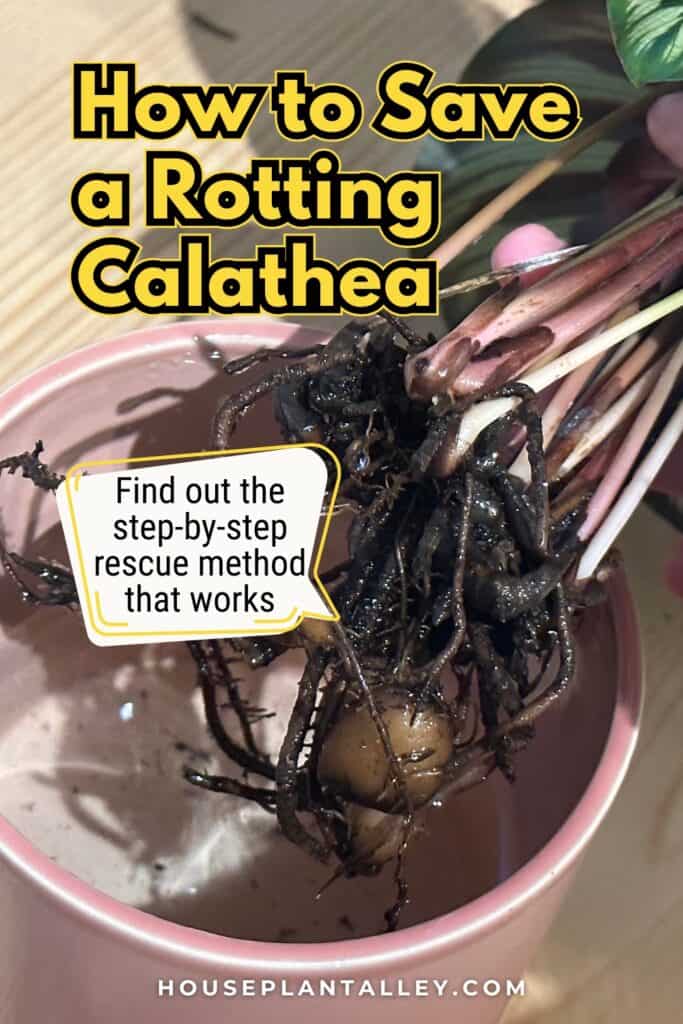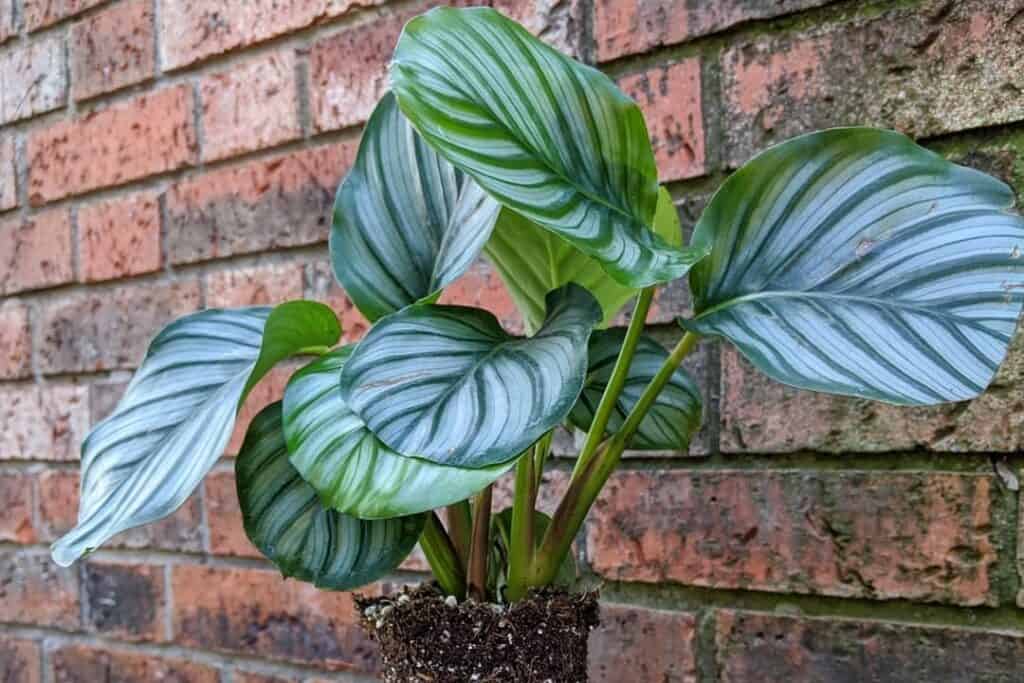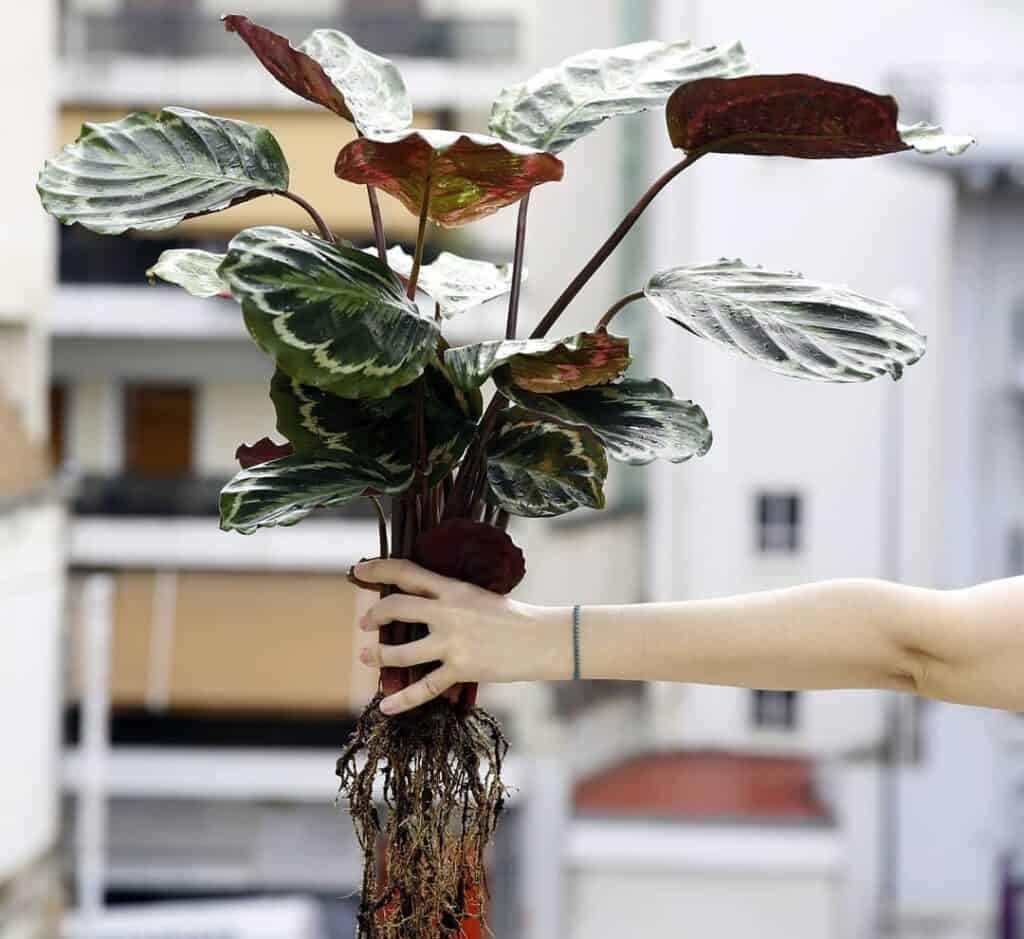Calatheas often suffer from root rot, one of the most devastating diseases. The disease can literally destroy a plant from the root up. It spreads quickly and without urgent treatment, it is too late.
Fortunately, if Calathea root rot is detected early it can be stopped. In this article, we explain what Calathea root rot is and how it occurs, how it can be diagnosed and treated, and most importantly, how it can be prevented.

Contents
- 1 What is Calathea Root Rot?
- 2 Signs of Calathea Root Rot
- 3 What Causes Calathea Root Rot?
- 3.1 1. Overwatering
- 3.2 2. Poor draining soil
- 3.3 3. No drainage holes
- 3.4 4. Oversized pots
- 3.5 5. Non-porous pots
- 3.6 6. Low temperatures
- 3.7 7. Poor air circulation
- 3.8 8. Deep planting
- 3.9 9. Dormancy watering
- 3.10 10. Contaminated tools
- 3.11 11. Buying infected plants
- 3.12 12. Compromised soil
- 3.13 13. Weakness or stress
- 4 How To Treat Calathea Root Rot
- 5 Advanced Calathea Root Rot Treatments
- 6 How To Prevent Calathea Root Rot
What is Calathea Root Rot?
In Calathea, root rot occurs when the plant’s roots are infected by rotting agents. The disease causes the roots to become brown or black sludge, which cannot transport nutrients. The disease can be fatal if left untreated.
The infection spreads rapidly from the roots to the rest of the plant. Viruses, bacteria, fungi, and oomycetes (aquatic fungi) are all possible causes of the disease. There are several common villains, including Fusarium, Pythium, Phytophthora, and Rhizoctonia, but basic treatments are the same no matter what.
In containers, Calathea are particularly vulnerable as their artificial environment can trigger an infection. Therefore, you should watch out that your green babies don’t become sitting ducks.

Signs of Calathea Root Rot
Detection of Calathea root rot at the earliest stage is crucial to recovery; unfortunately, the disease appears in secret at its earliest stage.
1. Early warning signs of root rot
A slow rate of growth is an indication that your Calathea roots might be suffering. Yellow leaves are another early warning. Check your soil if you notice a change in leaf color. Soil that remains wet can also indicate a problem. Another warning sign is curling leaves during the day but then recovering overnight.
2. Late-stage signs
In advanced cases, the stem can easily fall into your hand when you check the plant. If the infection doesn’t stop, the whole plant will eventually tip over.
What Causes Calathea Root Rot?
It is usually moist conditions that cause the infection of roots because pathogens thrive in moisture. These factors include:
1. Overwatering
Plants that receive too much water are more prone to rot. Overwatering smothers roots and reduces oxygen levels in the soil, allowing pathogens to flourish.
2. Poor draining soil
The tendency of heavy soils to hold water (and harden like cement) explains why well-drained soil is highly recommended for Calatheas: persistently wet roots are prone to rot.
3. No drainage holes
Water should be allowed to drain from containers for Calatheas. Stones at the bottom of the pot will not work, as the roots will stay covered with stagnant water.
4. Oversized pots
The desire to give your plants more space (and in the future save yourself a lot of trouble) can be tempting, but it is not always a good idea. Excessive soil can create a dead zone that floods as a result.
5. Non-porous pots
Despite their bulkiness, terracotta pots have one major advantage: the soil can breathe through them. Non-porous containers accumulate moisture and increase humidity.
6. Low temperatures
When temperatures drop, regular watering might be too much. This isn’t a problem in the controlled climate of your home, but remember that cooler weather causes less evaporation and water use.
7. Poor air circulation
The lack of air circulation also results in stagnant air and damp soil. Despite increasing humidity, grouping plants together can also decrease ventilation and contribute to soil remaining wet for a long period of time.
8. Deep planting
If you plant Calathea stems too deeply, they can rot. Reducing the planting depth will prevent this from happening.
9. Dormancy watering
The Calatheas’ growth slows or is dormant during the winter, so continuing the same watering schedule can result in unintended overwatering.
10. Contaminated tools
When you reuse equipment with other plants, you’ll want to sanitize it first, since pathogens can stick to pots, scissors, spatulas, and other equipment if they’re not sterilized.
11. Buying infected plants
It all started with a simple retail purchase that led to more than just a garden tragedy. Root rot is difficult to spot in its early stages but stay away from plants that have wilted leaves or swelling. Make sure you buy from reputable sellers and keep new purchases away from other plants for a few days before you know they’re healthy.
12. Compromised soil
The soil is a breeding ground for pathogens, which wait for spring to germinate. The majority of commercial mixes are sterile. However, avoid using soil from your garden or recycled media without sterilizing it first. Store the soil in an airtight container when not in use.
13. Weakness or stress
The majority of root rot infections occur as a result of opportunistic events. Along with overwatering, pathogens can also attack stressed plants caused by drought, physical damage, or even changes in light or other factors in the environment. It is essential to maintain a healthy plant to avoid problems.

How To Treat Calathea Root Rot
If your Calathea has root rot, take the plant out of its pot and wash the old soil off its roots. Cut off any diseased roots with sterile scissors, leaving only healthy ones. Don’t overwater the plant when transplanting it into a fresh, well-drained container.
Depending on the severity of the condition, treatment varies. Early detection can reduce the need for invasive procedures.
One day makes a difference when it comes to root rot. It is critical to treat root rot as soon as possible in order to save as many plants as possible.
While the plant is being treated, keep it away from intense light and stop fertilizing until it is healthy again. The roots are compromised and aren’t delivering nutrients as they should.
1. Treating mild Calathea root rot
There may be wilting and damp soil, but no odor, swollen stems, or other surefire signs of rot. In this case, you should stop watering the plant and monitor it carefully.
It is sometimes possible to reverse mild infections simply by allowing the soil to dry out and altering the way the plant is watered. This way, you can avoid transplant disruption that often complicates the recovery process.
In order to allow better evaporation, remove any mulch or fallen matter from the top layer of soil. The idea is to deny any developing pathogens the moisture they need and let your plant’s natural defenses take care of the rest.
If you do not have proper airflow through the container, consider carefully removing the soil from the plant. Place the block of soil together on a newspaper, then the soil will dry faster, giving the roots more oxygen. A fan will speed up this process.
2. Treating severe Calathea root rot
When the rot is extensive but the Calathea still has living roots, you will need to transplant it, removing all affected roots and leaves at the same time. However, please remember that transplanting a plant will give it another wave of stress, so take care to be gentle.
Follow these steps to get started:
- Remove the plant from its pot and inspect the roots.
- Get rid of the infected soil by washing the root ball.
- Take a pair of sterilized scissors and trim the moldy or brown roots off. (Be sure to re-sterilize the scissors after each use!)
- Remove leaves that have wilted or changed color.
- Remove about half the leaves to allow the plant to focus its energy on regrowing its roots.
- Plant the Calathea in fresh, dry, well-drained soil. Give them medium light and continue to water regularly.
- Keep your watering schedule light and cautious.
- Keep the plant isolated and under control. If the rot returns, dispose of the plant safely.
Remember
There are fewer roots on the plant now, so it requires less water.
3. Treating very severe Calathea root rot
There is little you can do to treat very severe cases as they will need to be thrown away. Do not let the infected Calathea come into contact with your other plants. Clean your equipment and containers after contact and dispose of the dirt. It is sad but inevitable.
Advanced Calathea Root Rot Treatments

Commercial fungicides for treating Calathea root rot
The use of commercial fungicides can be very effective, but they have limitations, such as not treating every type of fungus. The root rot may even be caused by a bacterium or a virus, which cannot be treated with fungicides.
If you have the time and money, an expert will be able to identify the pathogen affecting your plants. Some nurseries provide such services. However, without such a diagnosis, antifungal treatments are a shot in the dark, and chemicals aren’t cheap either.
Furthermore, fungicides can damage beneficial organisms in the soil. Ironically, this makes your plants more prone to rot.
Natural remedy for Calathea root rot
You have a few options if you want to solve Calathea root rot naturally. Many plant parents claim that natural treatments work, but others say they don’t.
1. Cinnamon
One exception to this is cinnamon, which has been found to be a natural, low-toxicity fungicide. While it may seem strange, it can actually help to reduce soil fungus and protect seedlings, as well as prevent root rot.
Cinnamaldehyde, an active ingredient in cinnamon, has been found to be effective against fungal infections in more than 40 different crops.
If you have Calathea root rot, sprinkle cinnamon on the roots and other affected parts of the plant after pruning the affected areas. Do not forget to mix it into the soil as well.
2. Chamomile
If your Calathea is recovering, consider adding chamomile tea to the irrigation water. Some plant owners have reported success using chamomile tea as an effective fungicide. Chamomile is similar to cinnamon, but it is liquid.
3. Hydrogen peroxide
One of the most common treatments for root rot is using a 3% solution of hydrogen peroxide, which will add oxygen and help combat infection. Hydrogen peroxide is commonly used in hydroponic systems for the treatment of root rot and can be used for treating Calathea root rot.
Using about 1-1/2 teaspoons of 3% solution diluted in a cup of water, spray on leaves and stems affected by the disease. This solution can also be dripped into the soil to help the plant recover.
The problem with this treatment is that it can also kill beneficial organisms, and its effectiveness varies from soil to soil. Some Calathea owners prefer to dip the roots of a heavily infected plant in water before transplanting it.
How To Prevent Calathea Root Rot
Prevention is the best approach to root rot, which is all about avoiding mistakes. Here are the requirements to avoid Calathea root rot:
1. Well-drained, sterilized soil
Plants like Calatheas don’t like dense soil in their pots. Fortunately, you can fix dense soil fairly easily.
The ideal soil for Calatheas is somewhere between impermeable clay that holds water and completely porous sand. Open, heavy dense soils can be adjusted by adding coarse sand, perlite, bark or other coarse aggregates, and vice versa.
The addition of organic matter, such as vermicompost and mold, improves the drainage of any type of soil and increases its fertility at the same time.
2. Watering correctly
When watering houseplants, don’t just water them all at once. Calatheas need much less water than ferns, for example. Soak the container, drain well, and allow the top layer of soil to dry between waterings. During cooler weather or during dormancy, less water is needed.
3. Choosing the right pot size
An appropriate pot size for a Calathea plant depends on how deep its roots are. When too much “empty” soil exists, dead zones can develop and contribute to root rot because there are not enough roots to absorb water and aerate the soil. There is not one size that fits all, so make sure you know your plant. Terracotta pots allow water to evaporate sideways and allow the soil to breathe, so they work best.
4. Good air circulation
Keep your plants well aerated to prevent stagnant conditions and they won’t contaminate each other.
5. Monitor your plants
Even experts admit that their failures were mostly caused by carelessness. A consistent observation is the most effective weapon against root rot.
Be aware of the condition of your plants and take appropriate action when necessary. Observe how quickly the soil dries and become familiar with its water use rhythm. Take note of any irregularities in their growth or coloring.
Despite the fact that Calatheas do not speak, they communicate. And if you learn their language, you can usually avoid the anxiety, guilt, and smelly mess of dealing with root rot.
